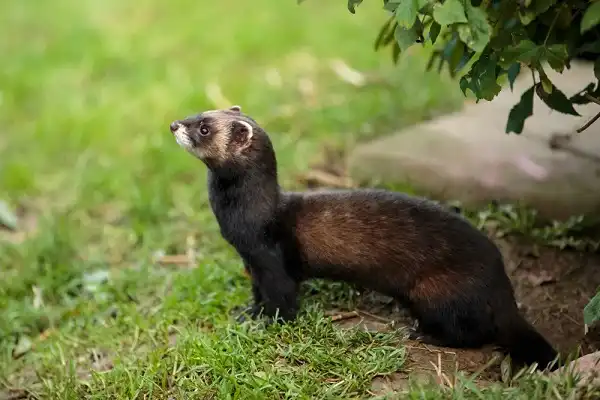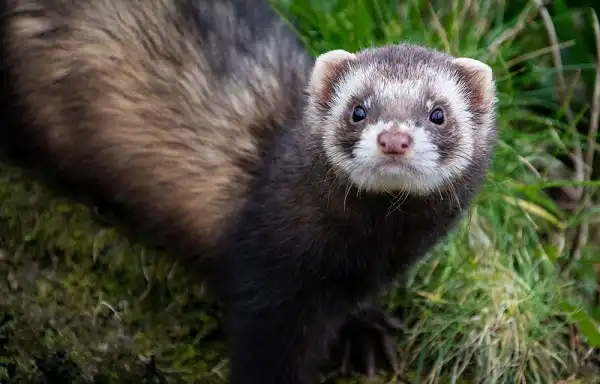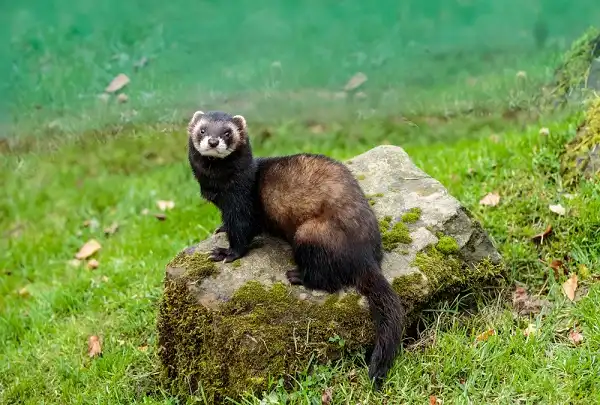For centuries, polecats have been mysterious creatures that inhabit woods and fields in many different parts of the world. These fascinating animals are famous for their distinct musky smell, their ability to climb trees, and their fierce hunting skills. Even though they appear spiny and unapproachable from a distance, these seemingly wild critters actually make great family pets when given proper care. For pet owners interested in learning more about these enigmatic companions, this blog post is here to provide insight into all things Polecat: from habitat requirements to feeding habits!

Polecat Description
The polecat, also known as the European polecat, is a member of the Mustelidae family, which also includes ferrets, weasels, and otters. These small carnivorous mammals have slender body, short legs, and curved claws, making them incredible climbers. They are about the size of a domestic cat and their fur color can vary from dark brown to black with a white underbelly. Polecats are similar in size to ferrets, but they are more robust and have broader heads compared to their domesticated counterparts. They are also larger than other mustelids, such as the stoat and weasel. The size of a polecat can vary depending on the geographic location, with those living in colder regions being larger than those in warmer areas.
Polecat Habitat
Polecats are adaptable creatures that can thrive in a multitude of environments, including woodlands, meadows, and even urban areas. They are found across Europe, from Wales to Russia, and are known in some places as ferrets or black cats. Polecats are solitary animals that tend to establish a territory where they can hunt and breed. They prefer habitats that offer a mix of grassland, woodland, and water sources. In the wild, polecats build dens in hollows or under trees and shrubs close to water, and they may also use the abandoned burrows of other animals. They are adept climbers that can scale trees and fences with ease, and they use their claws to dig for food and shelter. As pets, polecats need a habitat that mimics their natural environment, with plenty of opportunities for climbing, hiding, and exploring.
Polecat Diet
Polecats have an omnivorous diet that consists of both animal and plant matter. In the wild, their primary food sources are small mammals such as mice, voles, and rabbits. They may also eat birds, eggs, and insects. Polecats are opportunistic hunters that will eat whatever prey is available, and they have even been known to scavenge on carrion. As pets, polecats require a balanced diet that includes high-quality protein sources such as chicken, turkey, and fish. They also need fresh fruits and vegetables to provide the necessary vitamins and minerals. It is important to avoid feeding them sugary or processed foods, as these can lead to health problems such as obesity and dental issues. Some captive-bred polecats may benefit from a commercial ferret diet, which is specifically formulated to meet their nutritional needs. Water is also essential for polecats, and they should always have access to a clean, fresh supply. In the wild, polecats will drink from streams, ponds, or other bodies of water, and they may also obtain moisture from their prey. As pets, it is important to provide them with a water bottle or bowl that is replenished daily.

Polecat Size
The polecat, also known as the European polecat, is a mammal that belongs to the Mustelidae family. They are medium-sized animals that can grow up to 18-24 inches in length, with a weight ranging from 1.5 to 4 pounds. Polecats have slender body with a long, bushy tail that helps them maintain balance and agility. They have short, powerful legs with sharp claws that enable them to climb, dig and run with ease. Males are generally larger and heavier than females, with a broader head and neck and a more prominent chest. The coat of a polecat is typically brown or black with white fur on its face, throat, and belly. They have strong, muscular bodies and a flexible spine that allows them to contort their body in various ways. Polecats are fascinating creatures that are a popular choice among pet owners. Providing them with a suitable habitat, a balanced diet, and plenty of exercise and mental stimulation is key to ensuring their well-being and happiness.
Polecat Lifespan
The lifespan of a polecat can vary depending on various factors such as habitat, diet, and lifestyle. In the wild, the average lifespan of a polecat ranges from 2 to 3 years. However, with proper care and adequate nutrition, captive-bred polecats can live up to 5-7 years. One of the primary reasons for the shorter lifespan in the wild is the constant threat of predators and hunting. Polecats have several natural predators, including foxes, birds of prey, and larger mustelids, which can impact their lifespan. Additionally, polecats are susceptible to diseases and infections, which can also affect their longevity. In captivity, polecats can live longer due to a controlled environment that is free from predators and access to high-quality nutrition.
Providing a balanced diet that includes fresh fruits and vegetables, high-quality protein sources, and plenty of water, can significantly impact their lifespan. Vaccination against common diseases and regular health check-ups can help detect any health issue in the early stages, leading to prompt medical intervention. The lifespan of a polecat can also be impacted by the level of exercise and mental stimulation they receive. Polecats are active animals that require plenty of space to run, climb, and play. If they are kept in small enclosures with limited opportunities for exercise and enrichment, their lifespan can be drastically reduced.
Polecat Behavior
Polecats are highly active and curious animals with a playful, inquisitive nature. They have a tendency to explore their environment, using their sharp claws to climb and dig. Polecats are mostly solitary animals, but they do engage in social activity during the breeding season. Polecats are opportunistic predators and are known for their agility and hunting skills. They are carnivorous and feed on a variety of prey, including small mammals, birds, reptiles, and insects. They are also capable of catching fish and amphibians, making them highly adaptable to their environment. In addition to being skilled hunters, polecats are also excellent climbers. They have the ability to climb trees and buildings with ease, making them highly adept at accessing hard-to-reach areas. Polecats also have a strong sense of smell and are known to mark their territory with a pungent scent. Polecats are highly territorial and will defend their territory against intruders. They are typically nocturnal animals, but can also be active during the day. During the breeding season, males will compete for the attention of females and will engage in fierce battles with rival males.

Polecat Speed
When it comes to speed, polecats are known for their agility and quick movements. With their lean and muscular build, they are capable of reaching impressive speeds when pursuing prey or fleeing from danger. Polecats can run at an average speed of 23 miles per hour, making them one of the fastest predators in their size range. Their flexible spine and sharp claws allow them to easily navigate through rough terrain and climb trees and buildings with ease. They use their speed and agility to their advantage when hunting, often chasing after their prey in a zigzagging pattern, making it difficult for their prey to escape. Polecats can also swim quickly and are capable of catching fish and other aquatic prey. In addition to their physical abilities, polecats also have excellent reflexes and reaction time. This makes them highly skilled at avoiding obstacles and other hazards in their environment. They are also able to quickly change their direction and speed when needed, allowing them to outmaneuver their prey and predators alike.
Polecat Hunting
Polecats are skilled hunters, relying on their keen senses and impressive speed and agility to catch their prey. They primarily hunt small mammals such as rodents, rabbits, and birds, but will also eat insects and other small prey when necessary. When hunting, polecats use their sense of smell to locate their prey. They are able to detect the scent of their prey from a distance and will track it down by following the scent trail. Polecats are also skilled at stalking and ambush hunting, waiting patiently for their prey to come within striking distance before pouncing. Once they have caught their prey, polecats will often take it to a secluded location to eat. They are known to be messy eaters, leaving behind scraps and bones from their meals. This can be an indication of the presence of polecats in an area. While they are skilled hunters, polecats are also preyed upon by larger predators such as foxes and birds of prey. They have developed several strategies to avoid being caught, such as hiding in underground burrows or climbing trees to escape their predators.
Polecat Reproduction
Polecats are solitary animals that typically only come together for mating. The female polecat will give birth to a litter of up to 6 kits, which she will then raise alone in her den. The mother polecat will stay close to the kits for the first few weeks and provide them with food and protection. At around 8 – 10 weeks of age, the kits become independent and start to hunt on their own. Males reach sexual maturity at around 9 months of age, while females can begin breeding as early as 6 months old. During the breeding season, males will compete fiercely with each other for access to females. There is usually no pair bonding between male and female polecats, and they may not even recognize one another after mating season is over. Polecats are solitary animals that typically only come together for reproduction. Males reach sexual maturity at around 9 months old, and during the breeding season, they compete fiercely for access to females. After the mating season is over, there is usually no pair bonding between male and female polecats. As such, it is important for owners to provide their pet polecat with appropriate socialization and enrichment activities throughout the year in order to keep them healthy and happy.

Polecat as Pets
In addition to their impressive physical abilities and fascinating behavior in the wild, polecats can also make great pets. Their intelligence and playful nature make them interesting pets to own, although they are not recommended for novice owners due to their high energy levels and tend to be somewhat skittish around people. Owners should also note that polecats require a lot of interaction with their owners in order to stay healthy and happy. Polecats should have large enclosures where they can run around and explore, as well as plenty of hiding places and toys to keep them entertained. They do best on a diet of fresh fruits and vegetables, insects, small rodents, eggs, and cooked meat. It is important for potential owners to research the specific needs of polecats before bringing one home.
Conclusion
Polecats are impressive animals that have developed incredible physical abilities and hunting strategies to survive in their environments. Their speed, agility, and keen sense of smell give them the edge when it comes to catching their prey, while also allowing them to escape from predators with ease. In addition to this, polecats require enrichment for their well-being and happiness. This can include providing them with a variety of toys, treats, and activities that stimulate their natural instincts and behaviors. With the right care and environment, polecats can thrive and live long healthy lives filled with plenty of adventure!
Frequently Asked Question


